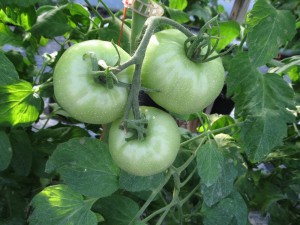University research demonstrates that yields are lower for staked tomatoes. Staking tomatoes is not absolutely necessary, but harvesting tomatoes on the ground becomes more difficult. Dirt and disease blemishes on fruits laying on the ground necessitate grading, cleaning, and disposing of culls.
Most tall growing indeterminate varieties are best supported off the ground in some manner to prevent loss of fruit from rots and sunburn. Wooden stakes and caging are the most common methods of support.
Wire caging offers the highest yields. Wire cages should be a minimum of 18 inches in diameter and constructed from heavy-duty reinforcing wire that is difficult to bend. Cages wrapped with clear plastic to a height of 18 inches provide some protection from cold winds and blowing sand. Plants in cages are generally not suckered.
Traditionally, indeterminate tomato varieties are individually staked, suckers removed, and tied with cloth strips, soft cord, or twist ties weekly until they reach the top of the 6 feet tall stake. Trellising is an alternative method. Tomato plants are supported by nylon cords that runs (weaves) from stake to stake, down the row on both sides, all supported on heavy duty poles or metal stakes at several heights.
Tomato plants develop many branches (suckers) as they grow. A common practice to remove the suckers to encourage larger and earlier fruit yields. Sucker removal make tying and spraying a lot easier. Better sunlight penetration and air circulation around plants leads to less leaf spot problems.


 Posted in
Posted in 
